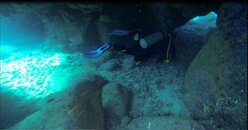I seem to have found myself in a spiral of thoughts regarding how much do I need to be safe.
...
What am I missing?
The fun!
Welcome to ScubaBoard, the world's largest scuba diving community. Registration is not required to read the forums, but we encourage you to join. Joining has its benefits and enables you to participate in the discussions.
Benefits of registering include
I seem to have found myself in a spiral of thoughts regarding how much do I need to be safe.
...
What am I missing?
Pardon me, since I didn't read every post thoroughly, but I have a question. I've never dived lava tubes, though I've explored some dry land versions of them. I'm going to take a wild guess that, at 24 dives, you and your son aren't cavern/cave certified. In practical terms, when is a lava tube not a cave? It is at the very least an extended overhead environment, is it not? How will you and your son deal with an emergency in this environment?

The fun!
AgreedKISS has/& always will be my motto........
There is no guarantee of safety in this life, it can be a noble goal or a fools journey, your choice.
N
Al least until my son and I get more dives, more training (rescue being one of them), and absolute blind comfort with our gear I think this will be my list:
- Cutting device (always)
- SMB (always)
- Slate/notes (only if we are going somewhere where we want to talk about what we are seeing. Otherwise just enjoy the dive. Practice hand signals
-Spare Air/Pony - Nope. We will focus on proper dive planning, sticking with the plan and keep practicing techniques to help ones self and each other
- Spare light - only when conditions warrant (low vis, night)
- Snorkel - I'd like to get a roll-up and get the thing off my mask, no spare. We were required to have it during classes and have just kept it in place.
Which?With heavy gloves on hand signals can get fuzzy.
Going back to my professional life, in HAZMAT training, the entry team always has an equal number of back-up in case they need rescue, but do not place their own lives at risk. I am always asked by new students " Who is the backup for the backup then?" My response is "good planning" on the front end. I think it applies here too.
